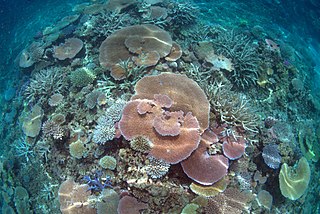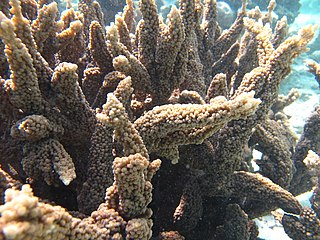
Acropora is a genus of small polyp stony coral in the phylum Cnidaria. Some of its species are known as table coral, elkhorn coral, and staghorn coral. Over 149 species are described. Acropora species are some of the major reef corals responsible for building the immense calcium carbonate substructure that supports the thin living skin of a reef.

Pseudoceros dimidiatus, the divided flatworm or tiger flatworm, is a species of flatworm in the genus Pseudoceros, belonging to the family Pseudocerotidae.

Prosthiostomidae is a family of free-living marine polyclad flatworms in the suborder Cotylea.
Amakusaplana is a genus of free-living marine polyclad flatworms in the family Prosthiostomidae.

Acropora hyacinthus is a species of acroporid coral found from the Indian Ocean, the Indo-Pacific waters, southeast Asia, Japan, the East China Sea and the western Pacific Ocean. It lives on shallow reefs on upper reef slopes, and is found from depths of 1–25 m. Crown-of-thorns starfish preferentially prey upon Acropora corals. It was described by Nemenzo in 1971.
Acropora abrolhosensis is a species of acroporid coral that was first described by John Veron in 1985. Found in sheltered lagoons and shallow reefs, it is listed as a vulnerable species on the IUCN Red List. The population of the species is decreasing, and most specimens are found in Western Australia, but occurs in many other areas. It is also listed under CITES Appendix II.
Acropora awi is a species of acroporid coral that was described by Wallace and Wolstenholme in 1998. Found in fringing reefs, the slopes of shallow reefs, and sandy slopes, it occurs in a marine environment. The species is rated as vulnerable on the IUCN Red List, with a decreasing population, and is easily damaged. It can be found over a large area but is not abundant.
Acropora batunai is a species of acroporid coral that was described by Carden Wallace in 1997. Found in protected, shallow reefs, it occurs in a marine environment at depths of up to 44 m (144 ft). The species is rated as vulnerable on the IUCN Red List, with a decreasing population, and is extremely fragile. It can be found over a large area but, overall, is not common.
Acropora caroliniana is a species of acroporid coral that was first described by Nemenzo in 1976. Found in tropical, shallow reef slopes, it occurs at depths of 5 to 25 m in a marine environment. The species is rated as vulnerable on the IUCN Red List, with a decreasing population. It is rare, but has been found over a large area, and two-thirds of the regions of Indonesia.
Acropora dendrum is a species of acroporid coral that was first described by Bassett-Smith in 1890. Found in tropical, shallow reefs in areas of powerful waves at depths of 5 to 20 m, it is threatened by disease. The species is rated as vulnerable on the IUCN Red List, with a decreasing population. It is not common but found over a large area, and is listed on CITES Appendix II.
Acropora derawanensis is a species of acroporid coral that was first described by Carden Wallace in 1997. Found in tropical, shallow reefs sheltered from the waves in a marine environment, it is found at depths of 10 to 25 m on reef slopes. The species is rated as vulnerable on the IUCN Red List, with a decreasing population. It is not common but found over a large area, and is listed on CITES Appendix II. It is easily damaged.
Acropora elegans is a species of acroporid coral that was first described by Henri Milne-Edwards in 1860. Found in sheltered, sloping reefs, this species occurs at 30 to 60 m depth. The species is listed as vulnerable on the IUCN Red List, and has a decreasing population. It is not common and has a small range, and is listed under CITES Appendix II. It is more resistant to disease than other Acropora species.

Acropora hemprichii is a species of acroporid coral that was first described by Christian Gottfried Ehrenberg in 1834. Found in shallow reefs in marine environments, this species occurs at depths of 3 to 15 m, and lives for between 13 and 24 years. The species is listed as vulnerable on the IUCN Red List, and has a decreasing population. It is common with a wide range, and is listed on Appendix II of CITES.
Acropora hoeksemai is a species of acroporid coral that was first described by Dr. Carden Wallace in 1997. Found in shallow reefs in a marine environment, it is found at depths of 8 to 20 m. It is listed as a vulnerable species on the IUCN Red List, and has a decreasing population. It is common, listed on Appendix II of CITES, and is found over a large range.
Acropora indonesia is a species of acroporid coral that was first described by Dr Carden Wallace in 1997. Found in marine, tropical, shallow reefs in sheltered flat locations or gentle slopes, it occurs at depths of 10 to 20 m. It is listed as a vulnerable species on the IUCN Red List, and it is thought to have a decreasing population. It is common and found over a large area, and is listed on CITES Appendix II.
Acropora kosurini is a species of acroporid coral that was first described by C. C. Wallace in 1994. Found in marine, shallow reefs, it occurs at depths of 8 to 20 m. It is listed as a vulnerable species on the IUCN Red List, and it is believed to have a decreasing population. It is rare but found over a large area, and is listed on CITES Appendix II.
Acropora loisetteae is a species of acroporid coral that was first described by C. C. Wallace in 1994. Found in marine, tropical, shallow reefs in sheltered lagoons, it is found at depths between 1 and 30 m. It is listed as vulnerable on the IUCN Red List, and it is thought to have a decreasing population. It is not common but found over a large area, and is listed under CITES Appendix II.
Acropora pharaonis is a species of acroporid coral that was first described by Milne-Edwards and Haime in 1860. Found in marine, tropical, reefs on slopes sheltered from wave action, it occurs at depths of between 5 and 25 m. It is classed as a vulnerable species on the IUCN Red List, and it has a decreasing population. It is common and found over a large area and is classified under CITES Appendix II.

Acropora polystoma is a species of acroporid coral that was first described by G. Brook in 1891. Found in marine, tropical, reefs on upper slopes where waves are strong, it occurs at depths between 3 and 10 m. It is classed as a vulnerable species on the IUCN Red List, and it has a decreasing population. It is not common and found over a large area and is classified under CITES Appendix II.
Endozoicomonas acroporae is a Gram-negative, rod-shaped, aerobic and non-motile bacterium from the genus of Endozoicomonas which has been isolated from the coral Acropora.





